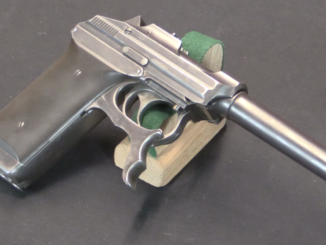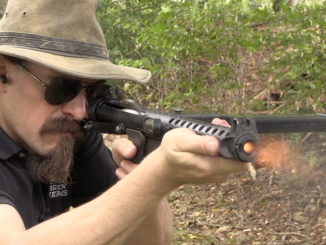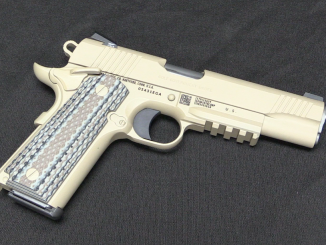We’ve all seen lever action rifles galore in movies about the old west, and most of us have handled and shot a bunch of them as well. But do you know where they came from?
Today we will take a look at the first American lever-action rifle put into successful (more or less) production, the Volcanic. We will then continue to examine the 1860 Henry and the 1866 Winchester to get a foundational understanding of the development of these guns, and the interesting group of people involved with them.




An interesting historical note, for over 100 years,Winchester stamped an “H” on the base of every rimfire round they made. This was to honor B.T. Henry and his contributions to the company.
So much for the rocket ball. A dud would be horrible to clear if clearance were even possible…
Excellent review – much appreciated. It is good to return to basics time by time.
Thanks……L
was the Volcanic mechanically identical (except for the extractor) to the Henry?
Basically, yes. The longer and beefier Henry receiver was to allow greater web thickness in the receiver walls to accommodate both the larger .44 rimfire cartridge and its greater operating pressures.
The .44 Henry Rimfire round originally had a cartridge case that was .815″ in length,later increased to .875″ or an even 7/8″. It is commonly referred to as the “.44 Henry Flat” due to the large meplat of its 200-grain bullet.
This was less to ensure a large ‘cut’ wound channel than to ensure against cartridges “cocking” in the magazine, as they might with a round-nosed slug as it slid on the flat head of the round in front of it. Later rounds like the .44-40 Winchester Center Fire retained the large meplat, to avoid possibly detonating a CF primer with a bullet nose under recoil.
The genesis of the .44 Henry round was relatively simple. Henry simply took the existing .22 rimfire cartridge used in S&W revolvers, and doubled all its dimensions. Twice the diameter, eight times the volume available for powder, etc. The Henry round was normally loaded with 26 to 28 grains of black powder, vs. 40 grains in the .44-40 and high-velocity .38-40 WCF rounds that succeeded it.
The .44 Henry round was commonly used in revolvers as well. Early conversions of percussion .44 revolvers to metallic cartridge were often built to chamber it simply on grounds of ammunition availability on the frontier. In addition, Colt produced the Model P (M1873 “Peacemaker”) revolver in .44 Henry, both in early lots for U.S. Army issue and in later intermittent production runs for sale in Mexico and elsewhere outside of the U.S., where (again) .44 Henry RF ammunition was more easily obtained than any American centerfire rounds.
Ballistically, the Henry’s 200-grain bullet departing the rifle barrel at 1,100 F/S yielded roughly 538 foot-pounds of muzzle energy, equal to a medium-velocity .44 Magnum or genuinely “warm” .357 Magnum load out of a 4″ to 6″ revolver barrel today.
Seen in its proper tactical role, a high-firepower weapon firing an “intermediate-power” cartridge, the Henry was in a very real sense the premier “assault rifle” of the American Civil War along with its competitor, the .56-52 Spencer. The Turks would use its offspring, the Winchester 1866 in .44 rimfire, to teach the Russians a thing or two about “sustained firescreens” at close range at Plevna in 1877.
Incidentally, the original Volcanic had a brief moment of cinematic glory in the second “Man With No Name” movie , For A Few Dollars More (1965).
Look closely at Manco (Clint Eastwood) as he’s sitting “refereeing” the final showdown between Col. Mortimer (Lee Van Cleef) and Indio (Gian-Maria Volonte). The rifle in his hand is a .41 Volcanic, and you can see by the magazine-follower that’s clear back at the receiver front that the magazine is empty.
But I wouldn’t bet against Manco having a single round in the chamber in front of that cocked hammer. And when did he ever need more than one shot for one target?
😉
cheers
eon
Manco needing more than one bullet per target? Only when the target is Mortimer’s hat.
Since you mentioned the Turkish Winchesters, didn’t some of them have water jackets? Those were for city walls and fortresses unless I’m totally wrong.
I’ve heard that, but never seen any documentation of it.
The first water-cooled high RoF gun I know of was the Civil War Ager “Coffee Mill” mechanical machine gun. Its single barrel heated up fairly quickly due to its 250 R/M rate of fire from its hopper feed.
The designer came up with two solutions that became very common in the early to mid 20th century. First, a screw-in, quick-change barrel, that could be swapped for a cool one in about a minute (not bad for the era).
And second, a water-cooling jacket that had a pump to circulate the water, hand-cranked by a soldier from a bucket.
So the full Ager gun team would have been the gunner, the loader who had to keep refilling the hopper with loaded and capped “chambers”, the loader’s helper, a guy on the pump crank and a guy whose job was refilling the bucket.
Or else the last two guys would be busy changing the quick-change barrels. Each one weighed twenty pounds and was about the size of a typical pry bar. Changing them was definitely a two-man job.
People who ask “why weren’t machine guns used more back then?” overlook the detail that while modern MGs get on just fine with a gunner, a loader, and maybe a helper, the guns of that era needed as big a gun crew as any 12-pounder Napoleon howitzer.
And they had to be at least as well trained, if not more so, as the Ager, Gatling, etc., were complex and often contrary beasts, even compared to a smoothbore muzzle-loading cannon, which was no picnic to operate, either.
Manpower was a concern back then, too. Especially when dealing with a weapon you almost needed a bloody Ph.D to figure out and keep running.
cheers
eon
Try this URL:
http://www.thefirearmblog.com/blog/2010/04/26/water-cooled-rifle/
Turks beating Russians at first attack at Plevna due Winchesters is a myth.
After war Turks quickly (relatively) phased Winchesters from army (except cavalry) to a local militias.
There was also a centerfire version of .44 Henry, also used by Turks. IDK if Winchesters in that caliber were original or conversions however.
Serbian gendarmes used captured Winchesters, including defense of Belgrade in 1915.
“.38-40 WCF”
Why this cartridge was developed? What was objective of its creator?
If I am not mistaken it was developed from 44-40, and has .40″ bullet (so why name it 38? to make even more confusion with .38-55 /also Winchester/?) but despite using LIGHTER bullet it has LOWER muzzle velocity. I don’t see not even one superiority of .38-40 against .44-40.
“Ballistically, the Henry’s 200-grain bullet departing the rifle barrel at 1,100 F/S yielded roughly 538 foot-pounds of muzzle energy, equal to a medium-velocity .44 Magnum or genuinely “warm” .357 Magnum load out of a 4″ to 6″ revolver barrel today.”
So far I know most powerful (in terms of energy) adopted in 19th century by military was 10.4x38R Swiss Vetterli (known is US as .41 Swiss rim-fire) which according to http://www.korabrno.cz/bal-info.html launched 334 grains bullet @ 1345 fps giving 1330 energy.
Why in 2nd half of 20th century no-one from American ammo manufacturers don’t try to introduce new rim-fire bigger than .22?
Remington in 1970s introduced 5mm Remington Rimfire Magnum which according to http://www.leverguns.com/articles/saami_pressures.htm give 37000 pressure, so it is possible to craft rim-fire cartridge with such pressure.
When it is no match for modern full-power rifle cartridge its looks enough for revolver cartridges (excluding most powerful Magnums, but including such cartridges as .357 Magnum – 35000 and .44 Magnum – 36000) and should allow production of some rifle cartridge as long as it has not too high pressure (.35 Remington has 33500 for example)
What would the advantages of rimfire cartridge at larger caliber than .22 be and why would ammo manufacturers try to introduce such a thing?
Are not rim-fire cartridge cheaper to produce?
Here you go:
The Volcanic:
http://www.google.com/patents/US10535
The Henry:
http://www.google.com/patents/US30446
The Winchester 1866:
http://www.google.com/patents/US55012
And we have Walter Hunt to thank for all of it. ^__^
Awesome video Ian! I really enjoy guns of this period, their history and their involvement with the Civil War and the ” Wild West”. Really enjoyed this video and can’t wait for more from Ian!!
It seems that the development of the lever gun, and guns in general, is as much, maybe more, about where ammunition was in its development than it was about the guns themselves. As ammunition improved the guns could be made to take advantage of it. A video on the history of metallic cartridges from the 1800 to 1900 would be very interesting.
Ian,
There is one example of the Hunt Volitional Repeater still in existence. It resides in the collection of the Cody Firearms Museum. You neglected to mention the Jennings Rifle. Any particular reason why?